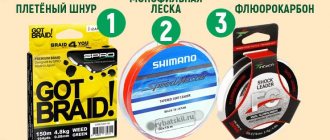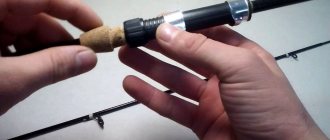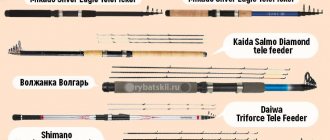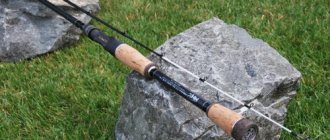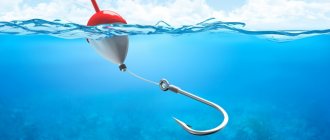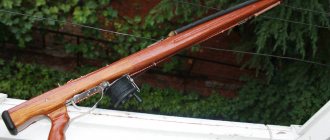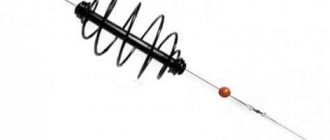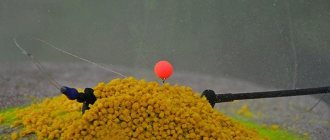Fly fishing gear
One of the most crucial moments is the choice of fly fishing gear. It consists of the following main elements:
- blank (rod)
- coil
- cord
- underbrush and bait
With this set of fishing accessories you can begin to get acquainted with fly fishing.
Additional details you will need later:
- floats and connectors
- carabiners and leashes
It is important to assemble such a fishing rod so that it is comfortable and obedient in the hands of a novice fisherman.
Rod
Fly fishing rods or blanks are usually divided into classes. As the class increases, the strength of the blank increases, and the rod is able to withstand greater loads.
It is best to take your first steps in fly fishing with a 6-7 class fishing rod. Its strength is enough for both 200 gram grayling and 4 kilogram lenok.
Rods usually consist of 2 or 4 legs:
Two-piece models are more reliable because they have fewer connections, which reduces the number of breakdowns.
Four-piece fishing rods have the advantage of being longer. The form can be made from different materials:
- bamboo
- fiberglass
- carbon fiber
You can successfully fish with a rod made of any material, as long as it is not too flexible.
Particular attention must be paid to the handle. If the material used is leather or rubber, then it is better to refuse such a fishing rod. Only a cork handle is worthy of consideration for fly fishing.
[rs]
Coil
Fly fishing reels are divided into three types:
- automatic
- cartoon
- ordinary
For a beginner fly fisherman, an ordinary model with an adjustable brake is suitable. The brake can be quiet or equipped with a ratchet. It is important that when the brake is in the tightened position, the cord does not come loose from the drum when tugging strongly on it. The weight of the reel should not exceed the weight of the fishing rod.
drum should accommodate 30-60 m of 0.4 mm diameter extension line under the fly line. The optimal volume of fishing line will be such that the cord does not rub against the edges of the reel when wound.
[rs]
Fly line
Along with the rod, fly line is the most expensive part of the tackle. This is explained both by its special parameters and rapid wear even with careful use.
During active fishing, you have to change the line twice during the season. The store may offer a sinking or floating option. With a floating model, it will be easier for a beginner to cast the equipment.
As for the class of the cord, it must correspond to the class of the fishing rod. Therefore, the optimal solution would be to purchase grade 6-7. Of all the colors, it is best to give preference to a white cord, which is most visible in the water.
Leader or leash
A fishing line with a reducing diameter is used as a leader in fly fishing gear. For a beginner, the best option would be a taper of 0.5 mm to 0.2 mm. The thick end of the leash is tied to the cord, and the fly is mounted on the thin end of the fishing line.
The diameter of the undergrowth should be thinned as follows:
- 0.5 mm length 125 cm
- 0.45, 0.4, 0.35, 0.3 and 0.25 mm, 15 cm long
- 0.2 mm length 60 cm
The total length of the leash will be 2.6 m. If the length of the rod is less than this figure, then it is necessary to shorten the section with a thickness of 0.5 mm. In strong winds it is more convenient to use short undergrowth. Therefore, you should prepare several leashes of different lengths in advance.
It is imperative to check the condition of the fishing line on the leash after a series of casts for any knots. They reduce the strength of the fishing line, so such undergrowth must be replaced immediately.
Fly fishing lessons
Photo by the author
Fly fishing is based on the use of artificial imitations of insects and their larvae, which are the favorite food of fish in a given body of water. This fishing is highly sportive and involves the use of special gear that is quite difficult to master. We invite you to get acquainted with the basics of fly fishing.
The rod, the most important part of the tackle, is like an extension of the fisherman’s hand. According to the international classification, modern fly fishing rods are divided into classes from 3 to 12. It is more convenient for a beginning fly fisherman to use a class 6-7 rod with a length of about 2.3-2.4 m. The structure of a fly fishing rod is a characteristic that shows how quickly the rod reacts to changes loads. So, a rod with an ultra-fast action bends in the upper quarter, with a fast action in the upper third, with a medium action in the upper half, with a slow action along the entire length. If the rod is made of high quality, even short, then even with it you can cast the bait very far. The best fly fishing rod has a cork handle. Its shape may be different. For beginners, we can recommend a fishing rod made of carbon fiber or fiberglass, but when choosing it, the help of an experienced fly fisherman is advisable. As a last resort, choose a rod with a slow action. Make several strokes of the rod and check its elasticity: if the vibration of the rod tip is felt by hand, then you can safely buy it.
A fly reel performs slightly different functions than a regular fishing reel: it is mainly needed for storing line and landing fish of medium and large sizes. There are three types of reels: single, automatic and multiplier. To begin with, the simplest one is enough - not heavy and with an adjustable brake, so that with a strong jerk the reel drum will spin with difficulty. You can also use a reel with a ratchet. The reel should hold 30-35 m of fishing line with a diameter of 0.4-0.5 mm. It is important that a fully wound fly line does not fall over the edges of the reel or rub against the partitions. This will prevent it from wearing out quickly.
However, when fishing for strongly resisting fish, a single reel does not always help. If the fish pulls the line so much that its supply runs out, there is a risk of losing both the fish and the tackle (holding the line with the fingers of your left hand does not help either), since the constant brake of a single fly reel does not have the force necessary for braking. Therefore, when choosing, you need to take into account that each class of cord must have a reel of a certain size, the required volume (for cord reserve) and with a brake block (thickening on the edge of the drum) for finger braking. It must be made of lightweight anti-corrosion materials and have no backlash.
Line is another component of fly fishing gear. Cords can be floating, weakly floating or sinking. The first and second are usually used for fishing on top, and the sinking one is used in deeper layers of water. They are painted in light or dark colors, respectively, and are also classified according to the change in diameter along the length. There are cylindrical, single cone, double cone and torpedo cords. Currently, the most popular are double cone (designation DT) and torpedo-shaped (designation WF).
For beginners, it is better to use floating cords. Start learning to cast with a torpedo-shaped line that has a heavier front part - a “torpedo”. It is easier to operate and with its help you can master long-distance (15-20 m) casting. After this, it is better to switch to a double cone cord, which is quieter on the water, scares the fish less and lasts longer: if its front part wears out, it is replaced with the back one (the aging of the cord is signaled by the front part, which, once in the water, begins to sink) . To extend its service life, the cord must be cleaned with a special product after each fishing.
A properly cast undergrowth lies straight on the water and does not wriggle like a snake, scaring away the fish. In order for the undergrowth to straighten well, it, like the cord, must have a taper with a diameter of the thick part of 0.4-0.5 mm, and the thin part from 0.25 to 0.41 mm (for beginners it is better to choose a thickness of 0.2 mm), and with a smaller diameter, in the event of a sharp or incorrect hooking, you can lose both the fly and the undergrowth itself, not to mention the fish. The undergrowth must be made of durable elastic material that retains its shape under heavy loads and resists twisting and stretching at the knots. The industry produces knotless and braided undergrowths. A good undergrowth can be knitted from pieces of fishing line of different diameters. The first, longest piece (125-130 cm) will also be the thickest (0.5 mm). The other segments, except for the final one, successively decreasing in diameter by 0.05 mm, have a length of 15 cm. The thickness of the last, thinnest end of the leash will be 0.2 mm (or less) with a length of about 60 cm. The best knot for tying is considered this way called a snake knot. This results in about 2.5 m of tapered leash.
If the length of the leader exceeds the length of the rod, then the thickest leader is shortened. And in case of strong wind, it can be shortened by another 5-10 cm. The undergrowth is tied to the cord with a tight knot, the protruding ends are trimmed as much as possible.
Make several test casts with a self-made undergrowth and then carefully inspect its node connections: small nodules may form as a result of incorrect casting. The damaged area is immediately replaced with a new one. But to learn how to cast, you don’t need complex undergrowth - a piece of ordinary nylon fishing line about 2.5 m long and 0.23-0.27 mm in diameter will do. You need to have 2-3 undergrowth with you when fishing. An experienced fly fisherman casts easily and gracefully, as if playfully. How to master this technique? Of course, it's better with an instructor.
First of all, you need to choose the right tackle and adjust all its components (preferably under the supervision of an experienced fly fisherman). It is better to start with a rod no more than 2.4 m long. The cord is preferable to class 6, heavy, white - it is less blown away by the wind and is better visible on the water. The fly, of course, can be replaced with cotton wool or foam rubber for now.
It is better to learn casting in an open space: a lawn or clearing, away from trees or bushes. A powerful swing transfers energy to the rod, and it, in turn, transfers it to the cord, which sends the undergrowth with the fly to the right place. Direct casting is performed with a cord pulled out from the reel (6-8 m), which is passed through the rings and laid directly in front of the fly fisherman (the whip is directed upward at a slight angle to the horizon). First, the cord is held with the left hand, brought to the handle and pressed against it with the index finger of the right hand. Then, with an upward swing, the cord is lifted from the ground and sent behind the back with a backward swing. After acceleration, the rod is stopped in the air in a position close to vertical. With the correct swing, the cord unfolds and flies behind the back along a strictly defined trajectory. It was noticed that the cord forms a loop, the dimensions of which directly depend on the force of the swing and the length of the acceleration section of the whip. By swinging backwards, you ensure that the loop formed by the cord unfolds along a narrow trajectory. In the future, this skill will be useful when casting in windy weather. In order for the line to run narrowly, the tip of the rod must be guided along a trajectory close to a straight line, and before swinging forward it should be tilted back a little. In this case, the cord will unfold and it can be fed forward.
The acceleration of the rod's movement should end at the top point (at the position of the dial hands at number 12). Excessive zeal will create a back wave, which will naturally affect the casting distance and accuracy. The backswing should impart only the energy required to the cord to unfurl it. The time for unwinding the cord is usually called a pause. Maintaining this very pause is an important element of casting. Only when the cord is fully straightened from behind will it not be difficult to feed forward, and all the force applied to the whip will be transferred to the cord without loss. Counter accelerations should not be allowed when one part of the cord is still flying backward and the other is already flying forward. This happens when the pause is too short. During a long pause, the forward movement of the cord begins not in the air, but from the ground, which leads to significant losses of its energy and the application of great physical effort. Regular practice will help you learn to pause. Having mastered the direct overhead cast at 10-12 m, you can move on to mastering other techniques.
When casting over a distance of more than 12 m, the left hand works more actively: it not only constantly pulls the line, but also accelerates it when casting forward, which is quite difficult. With the left hand, a simple or double pull of the cord is also performed when casting. When swinging the whip back and forth, they perform a simple pull of the cord, and when swinging both forward and backward, they perform a double pull. The so-called shooting casts are performed only with a double pull-up. Pull the cord with your left hand to avoid losing contact with the rod, as the cord sags when casting. Casting and pulling up should be brought to automaticity.
There are several ways to lay the cord in your hand. The simplest of them is when the cord is placed in small loops in one hand and released from it as needed. The second option is more complicated: the cord is wound in figure eights between the index finger and little finger, pressing with the middle finger. By moving your finger to the side, you can release the cord; it will unwind freely from your fingers. This winding creates a cord reserve of up to 15 m. The third method involves the presence of large identical loops. It is important to learn how to reset them so that the cord does not get tangled. To do this, it is evenly placed in a special bag or basket, sometimes in a wide pocket. Baskets are used for long casts. This method is convenient for wading fishing or if the left hand must remain free for some other purpose.
It is necessary to master the technique of lengthening and shortening the cord. Start with idle strokes. An idle swing back and forth is accompanied by gripping the cord with the left hand near the reel. When the whip goes back, with your left hand you pull the cord down from the reel. At the end of the swing, the force of the reverse movement of the cord is transferred to the hand, and if at this moment you lower it, then under the influence of the pulling force it will rush forward through the passage rings. This action is called shooting, and with its help you can extend the line by 5-8 m, which is very important for long casts.
Ring casting is used when there is not enough space. They can send a cord more than 10-12 m. It is carried out as follows. A floating cord (6-8 m) is placed on the water in front of you. Before casting, part of it is pulled back through the passage rings. Without allowing the arc of the cord to weaken, they sharply send the rod forward and stop it near the surface of the water. The cord is formed into a ring, which, unfolding, sends the fly forward. There are options for this casting: horizontal and side.
Throwing a tackle with a snake is used when there are any obstacles in a body of water with a current (a fallen tree, a huge boulder). In such places, zones are formed where the current more or less subsides, changes its direction or goes in a circle. This is where snake casting comes in handy. First, make 1-2 test casts to the target so that the cord stretches out in a straight line, and then add another 0.5-1 m. Then, aiming slightly higher than the desired location, send the cord forward with a strong swing. In this case, the rod is not lowered down, but held at an angle to the horizon. While the line is flying, make several quick lateral short movements with the end of the rod and in the last phase tilt the “tulip” towards the water itself. Thus, vibrations similar to the movement of a snake will be transmitted to the cord. Without stopping these vibrations, the tip of the rod lowers the fly onto the water.
Alexey Khludov August 24, 2012 at 10:00
Fly fishing flies
A beginning fly fisherman should have two types of flies:
- dry
- wet
As for sizes , you should start with numbers 3.5, 4, 5 and 6. Small baits like 2.5 should be excluded from the list.
For casting training, flies are not tied, just attach cotton swabs. It should be remembered that the front sights wear out quite quickly. Therefore, after each fishing they must be dried well.
From the variety of flies, we can recommend two universal models to a beginner:
- Wickham's Fancy dry fly (gold);
- Marchbrown wet fly (brown).
[rs2]
Fly line length
The length of the fishing line is 30-40 m. The conical part has approximately 4-5 m, while the main part has a cylindrical shape. Depending on the length and thickness of the fishing line, its weight is 28-45 g. The cylindrical section is heavier.
There is also a kind of double-cone fishing line. As you can guess from the name, both ends are conical, and the middle is traditionally cylindrical. The thickness of the conical ends and the cylindrical middle is different. For example, the characteristics of fishing line No. 1 “0.65-1.02-0.65” indicate that the thickness of the middle part is 1.02 mm, and the thickness of the ends is 0.65 mm.
Also, the thickness and strength of braided fly fishing lines are often indicated in the form of letter designations. Thus, the standard characteristics for fishing line No. 1 are expressed in letter form as “NEN”. The greater the weight and strength of the line, the higher the number used for the designation.
Fishing technique
There are several important stages in fly fishing.
- The most difficult moment when mastering fly fishing is casting a line with a fly. Watch a video on how to cast correctly. But it can only be mastered by persistent training under the supervision of an experienced fly fisherman.
- The next important stage of fly fishing is placing the bait. Depending on the type of fly, the presence or absence of a current, the angler’s actions will differ significantly. In any case, the cord must be taut in order to hook the fish when it bites.
- Landing fish in fly fishing has its own characteristics. Here you cannot force events, the fish must be tired, the strength of the current must be taken into account, and the line must not be tangled. You definitely need to take a landing net with you.
Correct casting in fly fishing on video - a series of detailed videos about correct casting of fly fishing.
How to choose a float rod for crucian carp and the technique of catching this cautious fish.Pike perch on jig - selection of baits and correct wiring.
Fly fishing tackle for beginners. How to make the right choice
- Fly fishing gear components ⇩
- Rod ⇩
- Coil ⇩
- Cord ⇩
- Leader or leash ⇩
- Installation of fly fishing gear ⇩
- Fishing technique ⇩
- Front sight selection ⇩
- Fly fishing knots ⇩
- How to avoid mistakes as a beginner fly fisherman ⇩
- Prices ⇩
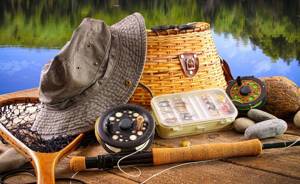
Fly fishing occurs in the upper layers of water without a float or sinker. This fishing method simulates the free fall of bait into the water. This is a complex and fascinating type of fishing, which is gaining more and more supporters in our time.
Fly fishing gear components
Rod

One of the most important components is the fishing rod. There are fourteen classes of such rods for fly fishing. The first and second classes correspond to the lightest gear. At the same time, catching fish with their help requires great skill.
Light rods are not intended for beginners. Rods of classes eight to fourteen are designed for catching large fish. The fifth, sixth and seventh classes of rods are well suited for those who are just starting to master this method of fishing.
They can consist of two or four elbows; in the first case, they are more reliable; four-piece models provide greater convenience for fishing. You can choose a fishing rod from any material, the main thing is that it is not overly flexible. It is best to choose a cork handle. It is more convenient.
Coil
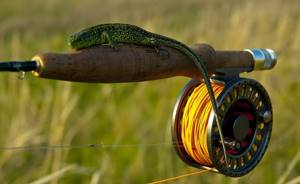
The next component of such gear that we will consider is the reel. There are three main types.
- Automatic.
- Multiplier.
- Ordinary.
When choosing, you need to make sure that the reel does not weigh more than the rod. It would be wise to choose a regular type of coil. Moreover, it must be equipped with a brake that will not allow the cord to unwind after a powerful jerk.
The reel drum must be designed for a cord length of thirty to sixty meters. It is optimal to use a cord of such length that when wound it does not rub against the edges of the reel.
Cord
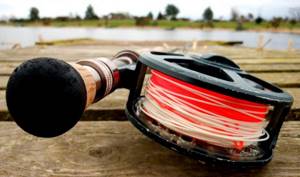
Just like the rod, the line is the most expensive part of the fly fishing tackle. If you actively engage in fly fishing, then most likely the line will have to be changed at least twice during the season. Its thickness must be selected in accordance with the class of the fishing rod.
If the fishing rod corresponds to the sixth or seventh class, then the cord should be chosen of the same class. They come in different colors. The most convenient one is the one that is difficult to see in the water. Therefore, using a white cord is more convenient. After fishing in dirty water, you should clean the line so that it is still invisible to the fish.
Leader or leash
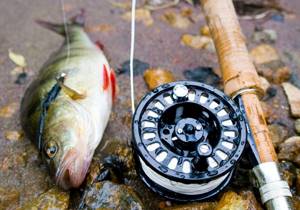
When fly fishing, a leader is used that is made from a fishing line whose diameter gradually decreases. The most convenient option is for its diameter to decrease from 0.5 to 0.2 millimeters along its length.
In this case, the thick end is attached to the cord, and the fly is attached to the thin end. The total length of the leash is usually 2.6 meters. If the rod is shorter than this value, then the leash needs to be shortened by at least half a meter. After each cast, the leash must be checked for knots. If they form, then it is best to change the undergrowth, since its strength from the knot sharply decreases.
Installation of fly fishing gear
When assembled, such gear has the following appearance.

The numbers indicate the types of nodes that are used to connect the components. The most common type of knot for attaching cord or backing to a reel is the arbor knot.
As you can see from the figure here, this knot is quite simple. In this case, another knot is additionally tied at the end of the cord or backing in order to increase the strength of the connection.
Next you need to tie the cord to the backing. For this purpose, the use of a special albright knot is provided.
Tie it like this:
- Fold the cord in half and hold the loop with two fingers.
- Thread 30 centimeters of backing inside the loop.
- Wrap the backing around the folded cord and thread it back through the loop.
- Tighten the knot.
Next, the cord needs to be tied to the undergrowth. A nail knot is usually used for this.
Nowadays, in most cases, there are special loops on the cord and on the pendant for a loop-to-loop connection. If they are not there, then you can use this node.
How to connect it is clear from the drawings.
Here, a small tube is used as an auxiliary tool, which is then removed.
Next you need to attach the leader to the leash. For this, a double surgeon's knot is used. It is very simple and at the same time very reliable.
To increase the strength of the last knot, it needs to be wetted before being completely tightened.
Now to finish installing the fly fishing gear, all that remains is to attach the fly to the leader. There is also a special node for this purpose. It's called improved clinch knot. It is also quite simple and yet reliable.
It is recommended to wet it before finally tightening it.
Fishing technique
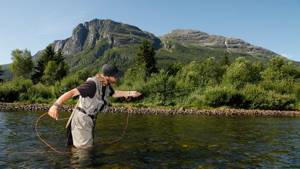
Successful fly fishing requires great skill. You need to make the fish believe that the fly you are throwing is a tasty bait that the fish cannot resist. To do this, you need not only to understand well what exactly needs to be done, but also to train long and hard in order to achieve success.
At the first stage, it makes sense to spend your time observing the life of the reservoir where you are going to fish. You need to take a closer look at what kind of fish behaves and what exactly it prefers to eat.
Next, in accordance with your considerations, you need to select exactly the fly that will give the highest chance of getting results.

When fishing, try to have different types of flies that you might like on that body of water. It is advisable to prepare at least two specimens for each species in case the bait is lost.
Trout can grab the bait and then swim away unnoticed. Therefore, it is important to be alert at all times and keep your tension tight, constantly watching it so as not to miss the fish.
In some cases, simulating a bite when fishing with a nymph can help. If the fish swims up, you need to pull the bait 15 centimeters. This may attract these fish.
In some cases, trout can be provoked into chasing your bait. If the fish gets carried away, it may swallow the hook before you even hook it.
Front sight selection
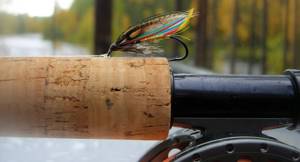
Sometimes a fisherman believes that choosing a particularly effective fly will provide an almost complete chance of success in fly fishing. Experienced fishermen rather believe that this gives no more than a twenty percent chance of success. Eighty percent of success comes from good fly technique.
Fly fishing knots

To attach various elements of fly fishing gear, it is customary to use certain nodes, which were described above. They have proven their effectiveness in practice, which has led to their widespread use.
How to avoid mistakes as a beginner fly fisherman
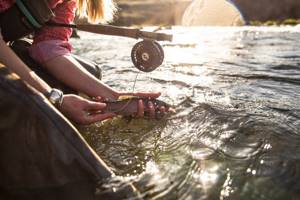
It must be remembered that movement and play of the fly are very important. In particular, it must correspond to the flow of water.
When choosing a fish with which to begin your improvement, it is recommended to pay attention to the bleak. Catching it is much easier than for other types of fish.
An important point for achieving success in fly fishing is the correct execution of fishing. First the fish needs to be tired. Then you need to move it, making sure that the tackle does not sag or get tangled.
Prices
A high-quality fly fishing rod is not a cheap thing.
SAGE One will cost 47,450 rubles, ORVIS Helios 2 will cost 36,000 rubles.
RIO Traut LT fly fishing line sells for 2,000 rubles. RIO Redfish will cost 4290 rubles.
RIO Dacron Fly Line Backing will cost 650 rubles.
Fly fishing is an exciting activity that requires great skill and dexterity. In order to achieve success in this field, you need not only high-quality equipment, but also knowledge combined with experience and constant improvement.
Rating: 5 1 votes
Video “Training fly fishing technique”
You can master fly fishing, like any other type of fishing, only on a river or reservoir. Thanks to practice, you will gain experience that with each subsequent fishing trip will help you accurately cast the bait, guide it into the fishing spot and calmly remove the prey from the water. Therefore, a beginning fly fisherman should devote all his free time to training and the fishing process.
primanki.com
How and from what can you make your own undergrowth for fly fishing tackle with your own hands?
Leader plays an important role in fly fishing, providing a smooth transition from thick line to thin leader and fly. Currently produced in a large and varied range, applicable to any fishing conditions. And the conditions can differ significantly - for example, fishing with a dry fly in calm water or with a light nymph near the bottom in a fast current. According to buoyancy, undergrowth can be divided into two groups - with neutral or close to it buoyancy and loaded - from insignificant to maximum possible. I will not go into detail into the classification of leader lines, but rather turn to the recent past, when leaders were made independently from monofilament fishing line of various thicknesses, ensuring a smooth and imperceptible transition from line to fly. Then any fly fisherman could tie the leader himself. During production, a fishing line from 0.5 mm was used and with a decreasing diameter to 0.18 mm or even 0.16 mm. Separate parts of the undergrowth of different thicknesses were connected to each other with a knot like this.
In the process of making your own leader, you need to try to adhere to certain sizes, which, in the old days, fly fishermen established through long searches. And as the most suitable one, it was composed of segments of the following lengths and diameters: 125 cm—0.5 mm; 15 cm—0.45 mm; 15cm—0.4mm; 15cm—0.35 mm; 15 cm—0.3 mm; 15 cm - 0.25 mm and finally 60 cm - 0.2 mm as a leader, which gives a leader length of 2.6 m. The length of the leader can also depend on your rod and should not exceed its length. Try to choose a durable and elastic material that can retain its shape even under load. Here are some options for different undergrowths:
When fishing in strong winds, you should choose a shorter leader. Previously, the thick end of the undergrowth was connected to the fly fishing line using a knot like this, but now they usually use a loop-to-loop connection.
Of course, there are certain advantages to fishing with commercially produced undergrowth, but if it is not possible to purchase it, then it makes sense to spend time and labor on its production. This will not be easy at first and often the knot will not be tied on the first try.
However, with experience, the process will go much easier and after a while making an undergrowth that is applicable to your fishing conditions will not be difficult. Just remember to trim the protruding ends of the knots to 0.5 mm. To fish with a dry fly in calm weather or with a loaded nymph at depth, make the thin end longer. I also often use self-made leader lines when fishing, but in the very recent past I had to fish exclusively with them. Of the shortcomings, I can highlight only two main ones - during the period of flowering of the water, greens cling to the nodules and a slight additional furrowing of the surface of the water with nodules when fishing from above.
- DIY fly fishing cord
- DIY fly tying bobbin holder
- DIY fly fishing reel
- DIY fly fishing rod
valeraprivalov.ru
Author: Pavel Kuptsov
›Mistake #1 - Fishing with dry flies without using floatant
Dry flies are baits that imitate insects that either accidentally fell into the water or intentionally ended up on its surface for the purpose of procreation.
during the fishing process, starting from the moment the fly appears on the surface of the water and until the moment of the next cast, it must be on the surface all the time.
Most novice fly fishermen, when buying dry flies, think that the material from which they are made should itself hold them on the surface, which, in fact, is confirmed by the first minutes of fishing - the fly adheres perfectly to the surface. However, after 7-10 casts, everything changes dramatically - the fly sinks as soon as it hits the water. Even idle casts (vigorous Overhead Cast casting with a short line length) used to dry dry flies do not help.
A dry fly begins to sink not because it is of poor quality and the fact that it is submerged under water does not mean that it urgently needs to be replaced with the same one, only dry. This suggests that the dry fly was not properly prepared for fishing, that is, it was not treated with flotant.
Flotant is a special product that greatly increases the buoyancy of a dry fly. This product is based on silicone and, as a rule, has a gel structure. To process the fly, a small amount of it is applied in a certain way to all elements of the dry fly (wings, brush and tail), which will hold it on the surface of the water during the fishing process.
› Mistake #2 - Studying and practicing fly casting without undergrowth
Leader is an integral part of cone-shaped fly fishing gear. It is a natural continuation of the fly line and its absence greatly deforms the process of reversing the final part of the line. This happens because a lot of energy accumulates at the end of the cord and has nowhere to go. The presence of undergrowth ensures an even distribution of this energy from the end of the line to the fly itself, which makes it possible to carefully and accurately place the line with undergrowth on the water in the place we need.
Many beginning fly fishermen, due to ignorance, quite often begin to study or practice casting without any undergrowth at all. The consequences of such training for the cord are very disastrous. Due to excess energy, its end begins to break, the cord becomes exposed, and the cord itself gradually shortens. The casting process itself suffers from this, since it is impossible to achieve a high-quality turn of the line in the absence of undergrowth.
Therefore, if you want to achieve maximum efficiency in the process of learning and practicing casts, make sure that there is always undergrowth at the end of the line. By the way, in order to save money, it can be replaced with a homemade undergrowth formed from several pieces of fishing line of different diameters. Its length should be approximately equal to the length of the rod.
› Mistake #3 - Fishing without first studying the casts
“Fly fishing is easy!” – having heard enough of such advertising slogans, many beginners find themselves very discouraged when, when they go out onto a body of water, they suddenly realize that desire alone is not enough for successful fly fishing. Many even begin to doubt their ability to use this method of fishing. However, abilities have absolutely nothing to do with it. As practice shows, anyone can master fly fishing, and one desire is really enough. The only thing you need to understand is that without first mastering the casting technique, fly fishing turns into sheer torture.
So that your first fishing trip doesn’t completely discourage you from developing your fly fishing skills, here’s some advice from experienced fly fishermen. Before you go fishing, master the basic fly casting technique at least at an elementary level. This will not only allow you to feel the beauty of fly fishing, but will also protect you from possible injuries.
You can master fly casting either independently or under the guidance of a fly fishing instructor. The first option is long and very difficult, requiring enormous patience, perseverance and time. The second option is also difficult, but mastering casting occurs several times faster and, most importantly, in this case the possibility of learning mistakes is eliminated.
› Mistake #4 - Forceful and tense fly casting
Proper execution of fly casting is based on almost complete relaxation. An experienced fly fisherman spends only the amount of energy necessary to complete the cast. Every beginning fly fisherman needs to remember this.
You also need to remember about the peculiarities of the initial stage of studying fly casting, where tension and forceful casting are an integral part of the process of developing the technique. It is impossible to immediately start performing a cast that is easy and relaxed, and any experienced fly fisherman will confirm this to you. Relaxation and ease in casting appear gradually as the level of casting technique increases.
A novice fly fisherman, if he wants to avoid getting tired while fishing, should strive for just this style of casting. All this will allow you to get maximum pleasure from fly fishing in the future, and the onset of this moment can be accelerated only through systematic training in developing casting techniques with an attitude of relaxation and ease.
› Mistake #5 - Fishing with heavy nymphs and streamers with poor casting technique
Without exception, all beginning fly fishermen underestimate the influence of fly weight on fly casting. And the influence is most direct and, moreover, negative. The heavier the fly used in fishing, the more difficult it is to cast and vice versa. Light flies (dry flies, edgers, light nymphs and wet flies) do not have any significant effect on the flight of the line and are therefore so easy to cast.
The use of heavy baits at the initial stage of mastering fly fishing, when the level of technology is still weak, can lead to quite serious negative consequences. This includes a breakage of the rod caused by a heavy bait hitting the rod, a puncture of the waders, and, perhaps the most unpleasant thing, the fly hitting your own body. All this is caused by a lack of understanding of the specifics of working with heavy baits and, as a consequence, chaotic and uncontrolled flight of the fly during the casting process.
Until the fly casting technique is mastered at the proper level, beginning fly fishermen are advised to fish only with flies that do not cause casting problems. These lures include almost all dry flies, emagers, unweighted nymphs, wet flies and light streamers.
© Fly fishing online store “FLY FISHING KITS.RU”
Article “The 10 Most Common Mistakes of Beginning Fly Fishers. Part 1"
nahlystovye-nabory.ru
Fly fishing gear components
Rod
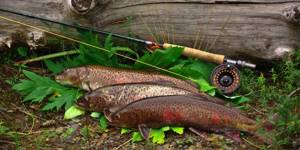
One of the most important components is the fishing rod. There are fourteen classes of such rods for fly fishing. The first and second classes correspond to the lightest gear. At the same time, catching fish with their help requires great skill.
Light rods are not intended for beginners. Rods of classes eight to fourteen are designed for catching large fish. The fifth, sixth and seventh classes of rods are well suited for those who are just starting to master this method of fishing.
They can consist of two or four elbows; in the first case, they are more reliable; four-piece models provide greater convenience for fishing. You can choose a fishing rod from any material, the main thing is that it is not overly flexible. It is best to choose a cork handle. It is more convenient.
Coil

The next component of such gear that we will consider is the reel. There are three main types.
- Automatic.
- Multiplier.
- Ordinary.
When choosing, you need to make sure that the reel does not weigh more than the rod. It would be wise to choose a regular type of coil. Moreover, it must be equipped with a brake that will not allow the cord to unwind after a powerful jerk.
The reel drum must be designed for a cord length of thirty to sixty meters. It is optimal to use a cord of such length that when wound it does not rub against the edges of the reel.
Cord
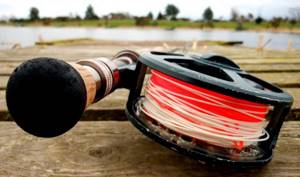
Just like the rod, the line is the most expensive part of the fly fishing tackle. If you actively engage in fly fishing, then most likely the line will have to be changed at least twice during the season. Its thickness must be selected in accordance with the class of the fishing rod.
If the fishing rod corresponds to the sixth or seventh class, then the cord should be chosen of the same class. They come in different colors. The most convenient one is the one that is difficult to see in the water. Therefore, using a white cord is more convenient. After fishing in dirty water, you should clean the line so that it is still invisible to the fish.
Leader or leash
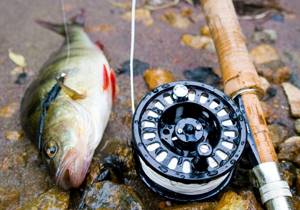
When fly fishing, a leader is used that is made from a fishing line whose diameter gradually decreases. The most convenient option is for its diameter to decrease from 0.5 to 0.2 millimeters along its length.
In this case, the thick end is attached to the cord, and the fly is attached to the thin end. The total length of the leash is usually 2.6 meters. If the rod is shorter than this value, then the leash needs to be shortened by at least half a meter. After each cast, the leash must be checked for knots. If they form, then it is best to change the undergrowth, since its strength from the knot sharply decreases.
Fly fishing for beginners
There are a large number of fishing methods, and fly fishing is one of the popular techniques. A fisherman who begins to master fly fishing can successfully use this equipment after a short period of time. Fly fishing requires not only technical skills, but also deep knowledge of the habits of certain species of fish, and you also need to be able to select the right gear for this type of fishing.
Fishing Features
The fly fishing technique involves surface casting a very light bait. Fish that feed on insects that have fallen into the water bite.
Fly fishing allows you to catch fish species such as grayling, trout, roach, and dace. Predators such as pike and perch are quite good at fly fishing, and bream can also be bitten.
Fly fishing for novice fishermen is not difficult; just string a fly on a hook or use an artificial bait that resembles an insect and cast the bait. Usually bites occur immediately after the fly is in the water. To effectively fish in this way, you have to move around the reservoir in search of more catchable places.
Gear selection
Fly fishing tackle for beginners to master this type of fishing should not differ from professional ones. If you start learning with gear that is not suitable for this type of fishing, you can get the wrong idea about the effectiveness of fly fishing as a fishing tool. If you don’t want to independently study the intricacies of selecting the main components of fishing gear for fishing in this way, then you can purchase a ready-made fly fishing kit for beginners. Such a fishing rod will already have the most balanced ratio of weight and technical capabilities and will allow you to immediately begin such an exciting activity as fly fishing. Those fishermen who want to thoroughly study the technical intricacies of selecting the components of fly fishing gear will need to study the requirements that apply to these parts.
Rod
Any experienced fisherman knows how to choose a fly fishing rod, but even professionals once had to start learning the basics of choosing the right gear. A properly selected fishing rod will allow you to fly fish for a long time without feeling tired. To choose a fishing rod suitable for this type of fishing, you should pay attention to:
- quality of material;
- rod test;
- build.
These are the main criteria for selecting a quality fly fishing rod.
The fishing rod can be made of the following materials:
- fiberglass is an inexpensive material of low quality, but light enough to be used for a short fly fishing rod;
- carbon fiber is a high-quality, lightweight and expensive fishing rod that allows you to fish in various ways, including using fly fishing equipment;
- laminated bamboo - this type of material is used for the production of luxury fishing products; it is lightweight and has an excellent appearance.
When choosing a rod for this type of fishing, you should also pay attention to the quality of the guide rings. It is necessary to carefully inspect the form upon purchase, and if deformation of the rings is detected or chips are found on their surface, then you should refuse to purchase such a product.
The rod test is also important for fly fishing. It is necessary to select products with a minimum value of this indicator.
The action of the rod must be very fast so that it can effectively cast a very light bait over a considerable distance. The length of the rod for fishing with this fishing method is 2 – 3.6 meters. For fishing in wide bodies of water, two-handed rods of greater length can be used, but using such rods for a long time is not recommended due to the significantly greater weight of such products.
Coil
This part should be miniature, but of ideal quality. All parts of the fly fishing reel are made only from high-strength plastic and ultra-light aluminum alloys. Typically, the weight of a reel for fishing with flies does not exceed 100 g. The use of such products will not make the structure of the fishing rod too heavy, which during long fishing
fishing with a rod in hand is the main criterion for choosing this product. For fly fishing can be used as inertial
models and multipliers, each variety has its own advantages and disadvantages, so the choice of model depends on the preferences and habits of the fisherman.
Leash
The leash for fly fishing should be made of thin but strong fishing line. Typically fishermen use monofilament for this purpose. The diameter of the fishing line should be no more than 0.25 mm. The length of the leash is slightly less than the size of the rod. For light flies, only high quality floating line is used. If there is a large amount of aquatic vegetation in the reservoir, then the best option for such fishing would be to use a fishing line with a greenish tint.
Backing
Fly fishing for beginners, when independently mastering this type of fishing, will require knowledge of special terms and designations. Backing is the addition of some line or fishing line to the main line used for fly fishing. For fly fishing, only high-quality fishing line is used, and the casting length of the gear rarely exceeds 50 m. To reduce the consumption of the main fishing line, cheap, low-quality material is wound onto the spool. In this way, it is possible to significantly reduce costs and use high-quality fishing line sparingly.
fishing line
Many fishermen are interested in the question: how to fly fish if there is no high-quality thin fishing line. To fish using this method, you need to purchase an expensive floating fishing line, but if you urgently need to fly fish, and there is no fishing line of suitable quality available, then you can use any fishing line with a diameter of 0.2 - 0.3 mm, having previously applied some kind of liquid to its surface. fat-like substance. For this purpose, goose fat works well, which is used to rub the fishing line along the entire length. Such gear can be used, but the effectiveness of such fishing will be
noticeably lower. Fly fishing gear of inadequate quality will not only not bring large catches, but if a large fish bites, it can lead to the loss of the trophy. A high-quality fishing line for this fishing method should be heavy and floating. In order for the fishing line used for fly fishing to remain buoyant for a long time, it is treated with a special aerosol, which can be purchased at specialized retail outlets.
Connector
This part of the fly fishing tackle is necessary to connect the main line and the leader. Thanks to the connector, the fisherman can easily replace the leader at any time. Some types of braided cords have a factory connector, but the quality of such a loop is not always the best, so many fishermen make this part themselves.
Front sight
In most cases, fly fishing gear is equipped with artificial flies. Inexpensive and effective models can be purchased or made independently. It is very difficult to say in advance what color and shape to choose a bait. The effectiveness of a particular fly can only be determined through numerous experiments. If you catch a fish and extract the contents of its stomach, you can choose a fly of a color and shape that resembles the natural food of this type of fish.
How to assemble a fly rod
For those fishermen who will be assembling their own fly fishing for beginners, it doesn’t really matter where to start. You can first install the reel on the rod, and only then wind the required amount of fishing line, install the connector and fly. Some fishermen go the opposite way. They wind the required amount of fishing line onto the spool, install the reel on the rod, and only then supplement the tackle with everything necessary. If all the parts were chosen correctly, then the result of this assembly will be excellent tackle for fishing using this method.
Fishing technique
This method of fishing has its own subtleties, ignorance of which will not allow the fisherman to achieve high results. To cast light tackle over a decent distance, you will need to make a fairly sharp swing with the rod. To do this, take the rod in the right hand, and the fishing line with bait in the left. The rod is wound back and with a sharp jerk moves forward, dragging part of the attached fishing line with it. The line that receives a push will move by inertia for some time. After splashdown, the bait is attacked almost instantly if there are fish in this place. Hooking is also done with a sweeping movement, but this should be done very carefully, because the elastic rod used for fly fishing is not capable of absorbing strong jerks. When the fish sits on the hook, it is reeled into the landing net. To increase the efficiency of catching fish with a floating fly, it must be treated with some kind of fat solution.
How to fly fish is clear from the above text, but this is only theoretical knowledge, which, if only read, will not add to the fisherman’s skill. Fly fishing lessons for beginners will only be beneficial when each point recommended in this article is reinforced in practice. Beginners should learn fly fishing from simple to complex. You should first study what kind of fish is caught by fly fishing, find out which fly fishing technique is suitable for a particular body of water. Very often, in order to get to the most fishing places, a fisherman has to go into the water; for this purpose it is necessary to purchase the appropriate equipment. If you manage to pick up any kind of fly that allows you to catch the maximum amount of fish in a given reservoir, then you should stock up on such products, because when fishing, it’s not uncommon to get caught in aquatic vegetation, and you can easily lose the “lucky” bait.
comments powered by HyperComments
rybalkanasha.ru
How to assemble fly fishing gear
A reel is installed, which is reinforced by winding under the main fishing line, in turn, a fly fishing cord is attached to it. Then a leash and a leash. At the very end the front sight is attached.
A fly fishing rod is needed to assemble the tackle and cast. When pulling out fish, it does not help the catcher in any way. All fishing rods differ from each other in length and thickness; it is according to these criteria that they are divided into several classes:
1. Rods that are used for catching small fish in shallow waters (the length of the blank is approximately 2 meters) - ultralight. 2. Length from 2 to 3 meters, used for fishing medium-sized fish in calm water - light. 3. A length of more than 3 meters is used in fishing for all types of fish, it is recommended for beginners - these are medium. 4. Recommended for large baits, large bodies of water, long casts - powerful.
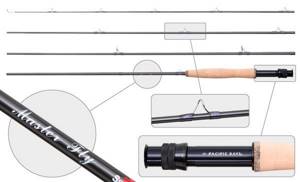
SurfMaster Fly Rod Series – progressive action fly rods
Since the reel is not involved in casting or retrieving, so that it does not interfere, the fly fishing rod has a special holder (behind the handle). It is recommended to buy reels together with the fishing rod.
An important element of the tackle is the cord , which serves as a weight, and it is with its help that you can cast any, even the lightest, fly. It is divided into the same number of classes as the rod. Each line class corresponds to its own fishing rod. Because if there is a light line on a heavy blank, the angler will not be satisfied with the casting distance. If it’s the other way around, the rod may not be able to withstand the load. Types of cords differ from each other in cross-sectional length. Beginners are recommended to use cylindrical cords in fishing, which are well suited for developing skills.
With any type of fishing you can catch big fish. If this happened in our case and there is not enough cord during wiring, backing will help. The undergrowth is designed to camouflage and protect the tackle.
Baits can be nymphs, streamers, flies . The latter can be made with your own hands from what is around, starting with matter and ending with wood. This bait is a dummy of caterpillars, various bugs and other insects. What type of bait to use depends on the fishing location and the fish being “hunted”.
Fishing lines
. So, with the help of fishing line they create a gradual transition from the cord to the fly. The packaging contains basic information about the fishing line - pulling force and diameter. The pulling force indicates the strength of the fishing line. This is the force required to break it. It is expressed in newtons. The diameter of the fishing line is indicated in millimeters. The strength in the knot is important, which is 80 percent of the normal strength of the fishing line. Strength can be increased by using more complex knots. The stretchability (degree of elasticity) of the fishing line also matters. Highly stretchable ones are not suitable for fly fishing. As for the color of fishing lines, in fishing practice they use colorless, green, gray, blue, golden, etc. The latest achievement is fluorescent fishing lines of the Sigma brand, which, when immersed in water, become invisible. They are quite strong, but not very stable in the knot.
Fly fishing. Fishing in still water
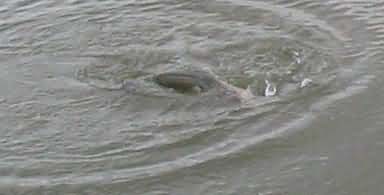
Fly fishermen are discovering more and more fishing opportunities and places. The idea of fly fishing for most anglers - non-specialists in this field - is almost always associated with fishing in flowing water with a floating line with a dry fly. This is, indeed, the most famous and surprisingly elegant and exciting way of fishing. However, it is not always possible to find a crystal river with trout and grayling or, at worst, with chub and ide, but there are plenty of lakes, reservoirs and ponds with relatively clear water everywhere. Fly fishermen are discovering more and more fishing opportunities and places.
In the West, fly fishing in enclosed waters is becoming increasingly popular. In Great Britain, the birthplace of fly fishing, lake trout fishing is generally a separate branch of fly fishing, with its own history and traditions. It is no longer a novelty to have German and English fly fishing clubs for zander and pike. This type of fishing is becoming increasingly popular in our country. You can fly fish for almost any fish in a pond, lake or reservoir. Still, there are several species of fish that are preferable to fly fishing in still water. These are trout (trout), grayling, char, whitefish, palia, pike, perch, pike perch, roach, ide, rudd, chub, bleak, sleeper. Modern fly fishing gear for fishing in still water has some features.
Rods
Manufacturers of fly fishing equipment offer for shore fishing fairly rigid, specially reinforced graphite rods of class 7-9, 2.9-3.3 meters long, designed for long-distance casting of heavy flies on “shooting head” type cords or the use of power casting with double draft on conventional torpedo-type cords. The working distance of fishing with such gear is 25-30 meters for “torpedoes” and up to 40 meters for “shooting heads”. When fishing from a boat, class 6-8 rods up to 3 meters in length are usually used. The requirements for the action of boat rods are less stringent, since they almost never fish at extreme distances from a boat.
Reels
Reels for lake fishing are not much different from river ones. It is only necessary to note that in lake fishing more often than in river fishing, fly fishing reels with multipliers and special reels of increased diameter for fishing with “shooting heads” are used. This is explained by the fact that, firstly, in still water a high speed of winding the cord is required in order to better contact the hooked fish, and secondly, even modern extension cords for “shooting heads” have a residual “memory” of the material and after storage they resemble spiral spring. The large diameter of the reel reduces this disadvantage; however, usually this unpleasant feature of extension cords disappears after the first ten casts. Selecting a reel for a fishing rod is easy. The main thing is to balance the long rod and accommodate enough main and extension lines.
Cords
The modern variety of cords offered for various fishing conditions can puzzle even an experienced angler. However, it is often not necessary to have all cord configurations. Fly fishermen need floating, fast-sinking and neutral buoyancy lines for fishing in still water. Nevertheless, it is worth having as complete an understanding as possible about the range of buoyancy lines and their purpose. Modern classification divides lines into floating, neutral buoyancy or very slowly sinking (intermediate), slow sinking, fast sinking and super fast sink. In addition, there is a special class of cords with a sinking tip (sink tip), in which the first 3-4 meters sink, and the rest is floating. The choice of line depends on what method you are going to fish, what type of fly to use, what style of retrieve and what speed of line selection you need for the best presentation of the bait. The quality of the cord is an important thing in shore fishing, since the casting distance and the presentation of the fly depend on it. In most cases, the more expensive the cord, the higher the quality.
Fishing with shooting head lines is not much different from fishing with conventional torpedo lines. Shooting heads provide a slight advantage in casting distance, but only in the hands of a specialist. Perhaps only one of their advantages attracted my attention - the ability to cast to the required distance with limited space on the shore. The length of the “shooting head” is 9-12 meters. If there are trees or bushes behind your back, then a normal cord cannot be deployed from behind. But it is often possible to overclock the “head”. Fans of shooting head fishing go to all sorts of tricks to place the extension line, since all of it must be released from the reel before casting. Many people use a special tray that is attached to the belt and where the cord is placed. However, in my opinion, this makes the angler clumsy and limits mobility. Some fly fishermen use a piece of plastic film and lay it out on the bank. However, when wading fishing, you can’t do without a tray - lifting 20-30 meters of extension cord from the water is almost impossible.
undergrowth
The conical leader is a very important part of the rig. Manufacturers are constantly improving this part, offering new models of undergrowth made from cutting-edge materials. One of the latest innovations is woven conical undergrowth. They are available in three types: "Trout" (trout), "Lightweight" (light weight) and "Salmon" (salmon). Trout leaders are required for fishing in still water.
Floating leaders are used for fishing with dry flies, suspenders, unweighted nymphs, emergers and buzzers on or directly below the surface film of water.
Neutral buoyancy leaders are almost identical in their characteristics to conical monofilament leaders and are used for fishing with unweighted nymphs, wet flies and weighted Lure flies (bait) at a depth of up to 1 meter. Ultra-slow-sinking undergrowth penetrates the surface film of water well and allows you to fish very slowly. This is especially important during summer nymph fishing in calm weather, when the water surface is smooth as a mirror. Slow-sinking leaders combined with floating lines make it possible to nymph fish slowly in deep water or quickly retrieve under the surface of the water with weighted Lure flies.
A fast-sinking leader connected to a floating line turns it into a sinking line, while you can control the depth of the fly. This combination is widely used when fishing from boats in large lakes. Ultra-fast-sinking leaders in combination with sinking lines are used for fishing in great depths. Lure flies and streamers require a very fast retrieve. In addition, these leaders are used for fishing with “floating” nymphs using the “suspended fly” method, as well as with “Booby” streamers when it is necessary to slowly move the fly close to the bottom. These undergrowths quickly deliver the fly to depth and keep it near the bottom, which is especially important when fishing for pike and pike perch in large lakes and reservoirs, as well as any fish in spring and autumn.
For small fish, lightweight braided leaders can be used, but their range of buoyancy is limited to three different configurations. You should not neglect simple monofilament or connected conical undergrowth, since they can be easily fished in standing waters. You just need to know that the sinking speed of the fly directly depends on the length and diameter of the leader and leader: the longer and thinner they are, the faster the bait sinks. The use of long (up to 5-6 meters) monofilament leaders and weighted flies is possible at depths of up to 4-5 meters with slow retrieve. Dive speed is limited by the use of short (1.2-1.8 meters) leaders in combination with bulky feather flies of the Palmer type or flies with floating inserts in the body. Monofilament undergrowth has a lower refractive index than braided undergrowth. In lakes with particularly clear water, where the fish are very wary, the use of monofilament conical leaders when fishing near the surface and at a depth of 1 meter gives excellent results, while the use of braided leaders reduces the number of bites.
Leash
It should be remembered that fish in a lake or reservoir sees a leash much better than in a river, so for fishing near the surface you should use leashes with a diameter of no more than 0.15-0.17 millimeters. Of course, this does not apply to fishing for zander, pike and perch.
Artificial flies
The most difficult thing, especially for beginner fly fishermen, is to choose the right fly for fishing in still water. The number of external factors influencing the choice (season, water temperature, light, transparency, bottom color, type of fish, etc.), as well as the personal preferences of anglers, have led to the fact that there are now thousands of flies on the market for fishing in standing water. Let's try, without going into subtleties and details (their knowledge always comes with personal experience and practice), to systematize the types of flies and the conditions in which they are used. The classification of flies for fishing in still water is not much different from their classification for fishing in a river. But still there are some peculiarities. Artificial flies for fishing in still water can be divided into three large groups.
Dry flies
They imitate natural insects and are designed for fishing on or in the surface film of water. Relatively recently, dry flies have appeared that do not imitate anything, but only serve as bite indicators when fishing with a freely drifting nymph. Their body includes buoyancy or is made from the fur of roe deer, reindeer or elk. They are used during summer fishing, when fish bites are very careful and cannot be noticed by the movement of the cord. Nymphs imitate the free-living and crawling larvae of dragonflies, mayflies, caddisflies, stoneflies and mosquitoes, part of the life cycle of which takes place in water. There are several subgroups in this group: emergers resemble nymphs of some species of mayflies, emerging through the water column to the surface, where their metamorphosis occurs; suspenders imitate the navel of caddis flies and mayfly nymphs, which are under the surface film of water and are preparing to become adult insects; buzzers - imitations of the navel of mosquitoes - reflect part of the life cycle of these insects when they need to come to the surface for a portion of air. By the way, one of the English names for these imitations is “Shuttle busser,” which means shuttle. Unlike river suspenders of the “Klinkhamer special” type, rooster feather parachutes are almost never used in suspenders for fishing in still water. Instead, various air-containing artificial materials perform the load-bearing function. These baits are used to fish throughout the entire water column, and with suspenders – near the surface film.
Wet flies
In this large group of lures, several groups are also distinguished: classic wet flies, streamers, lure flies (“Lures”). Some believe that the classic wet fly is an imitation of underwater spiders, beetles, free-living nymphs that have partially deployed wing buds and float to the surface to transition to the next stage of development, or a sunken but still moving adult insect. Others argue that a wet fly does not imitate anything and its attractiveness to fish can be explained by anything, including its resemblance to natural insects. In my opinion, the main thing that attracts the attention of a fish and makes it try an artificial bait is the color, size and moving elements in the feather of the fly, which create the illusion of life. You should also take into account the predatory instinct of the fish: it grabs everything that moves and is smaller in size. The coverage area of these classic wet flies is the surface layer of water, up to 1 meter deep.
Streamers
This type of flies is used to catch throughout the entire water column, as they resemble fry and small fish: minnows, bleaks, sculpin gobies, etc. These flies work best in shallow water and near the surface of the water. Recently, bait flies (“Lures”) have become widespread. In their production, modern materials, highly mobile elements in the body of the front sight, holographic films and bright luminescent paints are used. Fly fishermen are full of ingenuity and imagination. Unfortunately, the modern classification of flies is clearly overloaded with terms. Every big-name fly fisherman (and fishing directory) strives to add something “very personal” to the existing fly taxonomy. The uninitiated are often taken aback by names such as “Pellet Flies” or “Idiot proof nymphs,” which can be translated as “compound feed flies” and “impenetrable idiot nymph.” Moreover, the latter are not even approximately similar to nymphs.
Sometimes in the fly boxes of modern Western fly fishermen, especially those specializing in catching rainbow trout, there are practically no natural imitations. Here's some friendly advice: don't buy "crazy flies" just because they're featured in a famous catalog or because they're pleasing to your eye. More often than not, these lures are designed to catch anglers, not fish. The only fish that can covet these flashy flies is a rainbow trout that has seen nothing but feed and grown in a cage. For fishing in a lake, it is best to use natural imitations of insects that live in a given body of water. Each artificial fly is used at a specific time of year, although there are also all-season, universal lures.
In the southern regions of Russia you can sometimes fish in January and even February. Streamers, bait flies and weighted nymphs, as well as bloodworm imitations (mosquito larvae), are common in winter conditions. It should be noted that Russia has several climate zones, and this table is only a visual example. Each fly fisherman should make for himself his own table for the use of flies corresponding to the climate zone in which he lives. The size of the fly usually depends on the size of the hook on which it is tied. It should be noted that the size of the flies used decreases from spring to summer and increases from summer to autumn. On hot summer days, fly fishermen sometimes use tiny flies with a body length of 2-3 millimeters on hooks No. 18-24. Often there is no particular need for this, since it is more difficult for fish to see the details of a No. 20-24 fly than on a regular size No. 10-14 bait. In addition, on flies that are too small, errors in tying are more noticeable. The most important parameters in evaluating an artificial fly are its size, color and silhouette. To select the fly that is most attractive to the fish in the intended fishing area, the fly fisherman, arriving at the reservoir, must inspect the leeward shore and look for dead insects or discarded hatching cases. It’s a good idea to inspect both the coastal vegetation and the shallow waters of the reservoir.
The best way to find out what a fish is currently eating is to check the contents of its stomach. The easiest way to do this without damaging the fish is with a simple tool called “Spooning” (from the English word “spoon” - spoon). It is compact and also serves to euthanize fish. “Spooning” is introduced through the mouth into the stomach of the fish, made one turn and removed out. I think any fisherman on the shore will not mind if you ask him to check the stomach contents of the fish he caught with this instrument. In any case, this should be done with the first fish you catch. If there is no "spoon", use your knife and the traditional "surgical" method.
undergrowth
. This element of gear, which ensures a smooth transition from line to fly, is made by anglers themselves from pieces of fishing line of different diameters. They are also factory-made. Some fly fishermen prefer a cylindrical leader made of fishing line with a diameter of 0.25-0.15 millimeters. It is quite acceptable on small bodies of water where long casts are not required, and requires great experience and skill of the fisherman himself. But it can be unequivocally stated that perfect tackle is only possible with a conical undergrowth. The undergrowth is connected to the cord using various knots, but only some of them are of high quality. The conical leader is a very important part of the rig. Manufacturers are constantly improving this part, offering new models of undergrowth made from cutting-edge materials. One of the latest innovations is woven conical undergrowth. They are available in three types: "Trout" (trout), "Lightweight" (light weight) and "Salmon" (salmon). Trout leaders are required for fishing in still water. The first to offer it to the gear market was the English company Airflo. It makes sense to give a classification of the buoyancy of these undergrowths, since other companies that also now produce conical leaders with braid adhere to this or a similar classification. We proceed from the fact that the connection should be durable, aesthetic and small in size. And one more requirement: the fishing line must be a continuation of the cord, that is, not deviate from its longitudinal axis. The best knot, undoubtedly, is the king knot, which has a strength of 91 percent and which ensures the continuation of the fishing line of the cord. Knit it with a needle. The leader knot is somewhat worse - it is larger, heavier, and less durable. The polyfill cord can be connected to the undergrowth using an end ring. It must be inserted into the cord very carefully and exactly in the center. Then it will serve long and reliably. Some older fly fishermen prefer to glue the leader to the line. Today's high quality adhesives provide a strong and reliable connection. But this method is quite labor-intensive and the quality it gives can be achieved by a simpler method. An original solution is proposed by engineer Shimek - thread the upper end of the undergrowth into the cord using a needle. This is only possible with polyfill cords. When piercing the cord with a needle, you must try not to pierce its shell before you have inserted at least 10 millimeters of undergrowth into the cord. Then you need to make two or three knots on the undergrowth that will securely fix it, and cut off the end of the undergrowth at the last knot, leaving about 1 millimeter. This connection does not interfere with the passage of the cord and undergrowth through the guide rings of the rod. A coarse fishing line with a diameter of 0.35-0.40 millimeters can easily be threaded inside a cord of grades 4-7. It is convenient to use forceps or a surgical clamp. The length of the leader should not exceed the length of the rod without the handle. Different fishing methods and different fish require different leaders. Thus, experienced fishermen who prepare their own bait adhere to slightly different principles. When fishing for trout (April, May), a three-part undergrowth with lines of 0.35-0.30-0.25 millimeters is required. With the onset of summer, they switch to fishing lines of 0.30-0.25-0.20 millimeters. This undergrowth can be considered universal: it is suitable for fishing on most fast-flowing rivers, where large fish live that offer significant resistance to attraction.
When fishing with dry flies and where large fish are not expected to be caught, you can use undergrowth of 0.35-0.25-0.15 millimeters; sometimes the last segment has a diameter of even 0.12 or 0.10 millimeters, but this requires high skill in controlling a soft rod and light cord, as well as the ability to gently hook.
Installation of fly fishing gear
When assembled, such gear has the following appearance.

The numbers indicate the types of nodes that are used to connect the components. The most common type of knot for attaching cord or backing to a reel is the arbor knot.
As you can see from the figure here, this knot is quite simple. In this case, another knot is additionally tied at the end of the cord or backing in order to increase the strength of the connection.
Next you need to tie the cord to the backing. For this purpose, the use of a special albright knot is provided.
Tie it like this:
- Fold the cord in half and hold the loop with two fingers.
- Thread 30 centimeters of backing inside the loop.
- Wrap the backing around the folded cord and thread it back through the loop.
- Tighten the knot.
Next, the cord needs to be tied to the undergrowth. A nail knot is usually used for this.
Nowadays, in most cases, there are special loops on the cord and on the pendant for a loop-to-loop connection. If they are not there, then you can use this node.
How to connect it is clear from the drawings.
Here, a small tube is used as an auxiliary tool, which is then removed.
Next you need to attach the leader to the leash. For this, a double surgeon's knot is used. It is very simple and at the same time very reliable.
To increase the strength of the last knot, it needs to be wetted before being completely tightened.
Now to finish installing the fly fishing gear, all that remains is to attach the fly to the leader. There is also a special node for this purpose. It's called improved clinch knot. It is also quite simple and yet reliable.
It is recommended to wet it before finally tightening it.

